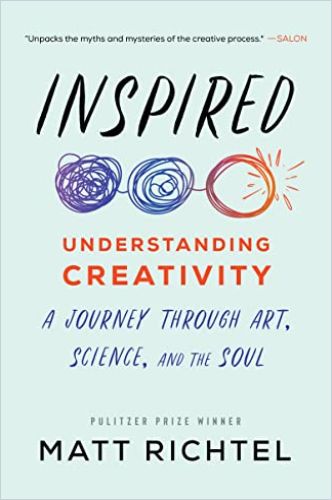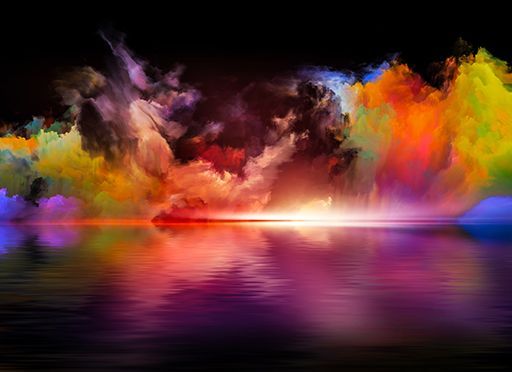Pulitzer Prize–winning New York Times journalist Matt Richtel probes the mysteries of human inspiration.

The Mystery of Creativity
Creativity is innate to human beings. It’s primitive – embedded in your biology. It resembles and stems from the incremental process of evolutionary development. As organisms reproduce, some offspring show genetic mutations. Many of these mutations are unimportant or unhelpful. But occasionally, a mutation or mutations enable an organism to better adapt to its environment and outlive its peers. These mutations, like great works of art, endure.
Creativity lives inside each of us, and, collectively, we create our world.Matt Richtel
Creativity is a divergence from the status quo that offers something influential or important, Matt Richtel argues. From the discovery of fire to the invention of modern medicine, humans have proven to be “creativity machines.”
Authentic creations flow from a person’s emotions and experiences. This sort of creation feels honest and pleasurable and may trigger feelings of vulnerability in the creator. Inauthentic creation often feels forced.
People’s lived experiences and emotions are the raw ingredients of their creativity, Richtel notes. The more rich and varied these experiences, the more a creator appreciates the “multitudes” the self contains and the more material for creation becomes available within and without.
Creative Characteristics
You may think creative people are geniuses. This usually isn’t the case, Richtel claims. Above a threshold IQ of 115 to 120, greater intelligence does not predict greater creativity. Average intelligence is sufficient to support outstanding levels of creativity. However, certain characteristics do set highly creative people apart.
Would-be creators live and observe life. They navigate work and relationships; they experience joy and sorrow, contradiction and uncertainty. They reflect, connect dots and blend these sometimes-inconsonant ingredients into profoundly personal creations.
Creativity can blossom at any point in life. Inspiration may strike suddenly or emerge gradually; it may “peak” within a few years or continue for decades.
Creative people generate a high volume of ideas. They test their ideas without thinking too much about whether they will work. Creators such as Pablo Picasso, Thomas Edison, Johann Sebastian Bach and Albert Einstein experimented constantly, and many of their attempts turned out to be dead ends. Innovators such as these value the process of innovation itself. This mindset prevents them from filtering out ideas before testing their viability.
More rigid thinkers blind themselves, physically, to the material that surrounds them in the physical world.Matt Richtel
Richtel notes that creative people show a high degree of “openness” and neuroticism. Openness is curiosity, flexibility of mind and a “willingness to embrace new experiences. Neurotic individuals experience anxiety while displaying “emotional sensitivity and vulnerability.” Both openness and neuroticism render a person more receptive to information, either from external (openness) or internal (neuroticism) sources.
Creative people absorb more visual information than their less creative counterparts. Sensory inputs and experiences provide fodder for creativity.
Despite its positive connotation in Western societies, creativity frightens people at a subconscious level due to the instability it may bring. Authentic creators demonstrate exceptional confidence, which enables would-be creators to absorb information that might threaten non-creative people. Confidence keeps creators moving forward in the face of potential failure or rejection.
Cultivate Creativity
Differences in personality and upbringing mean that creativity comes more naturally to some people than others. But cultivating greater creativity is possible for anyone, Richtel writes.
Recognize any potential inner barriers to creativity. A typical school experience can turn a wildly imaginative child into a conventional thinker. Other inhibiting experiences include growing up in a household with excessive rules or striving to earn the affection of your parents.
Modern life presents a barrage of distractions that drown out your inner voice. Quiet the mind to notice what is happening around you and to leave space for new ideas to surface. Bursts of inspiration originate in parts of the brain that take charge when you are relaxed. Mindfulness and daydreaming unleash creative ideas; recreational drug use appears to have little positive effect on creativity.
The number one enemy of creativity is perfectionism. There isn’t even a close second-place enemy.Matt Richtel
Fostering creativity requires psychological safety. Even if people can hear their creative voice, they often react by judging, questioning or shutting down their ideas. An unspoken fear of judgment can keep the conscious brain away from risky ideas. Breathing and meditation exercises help change the brain’s threat perceptions. As creators mature, they learn to listen to their voice with trust and acceptance; it becomes a safe space for their inspiration to mature.
Luck and Divergence
Transformative innovations often come as the result of luck. Best-selling singer/songwriter Bono, for example, believed that his band U2’s early success depended, in part, on the timely, widespread adoption of car stereos, which emphasized the appeal of entire albums over individual songs.
According to Richtel, creations that catch on also balance novelty and relevance. Young male zebra finches searching for a mate, for example, imitate the songs of older birds, then add their own twists, but nothing so different as to sound weird.
Review
Richtel mines his own creative journey to offer a guided exploration for those curious about creativity’s essence and how to foster it. By describing how he researched creativity and his own blocks, Richtel provides a memoir of sorts. He also offers his take on various research studies examining creativity and how you might harness the results of those studies to further your own creative output. The result is a worthy, detailed overview of the relationship between a creator’s psychological makeup and his or her output. Readers looking for a comprehensive how-to manual for creativity should look elsewhere. But those seeking a thoughtful, humorous and perceptive consideration of creativity’s many complex facets will enjoy Richtel’s considered and rich essays.





